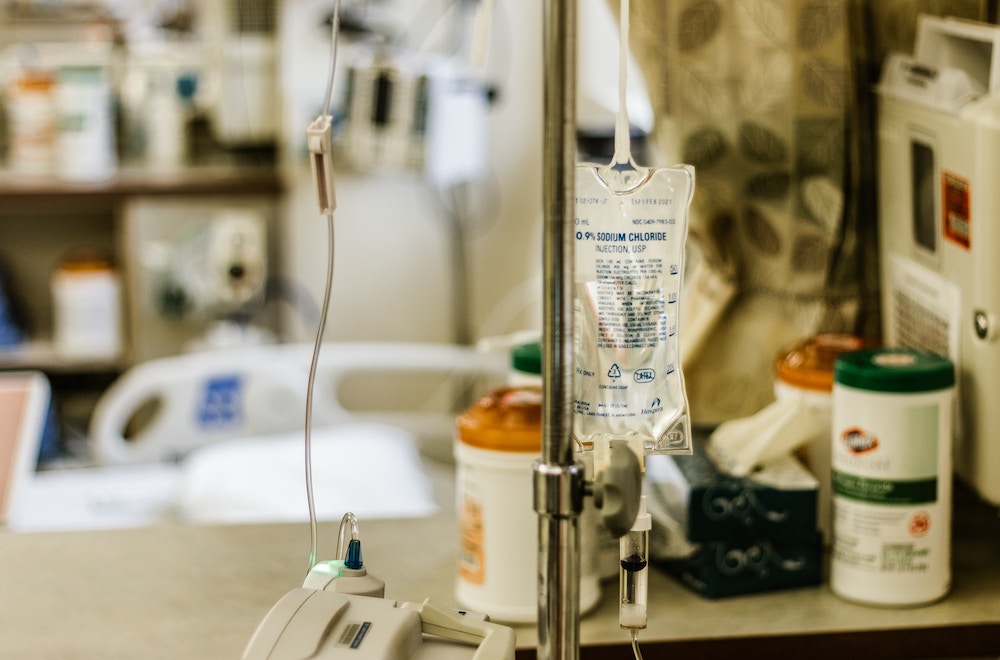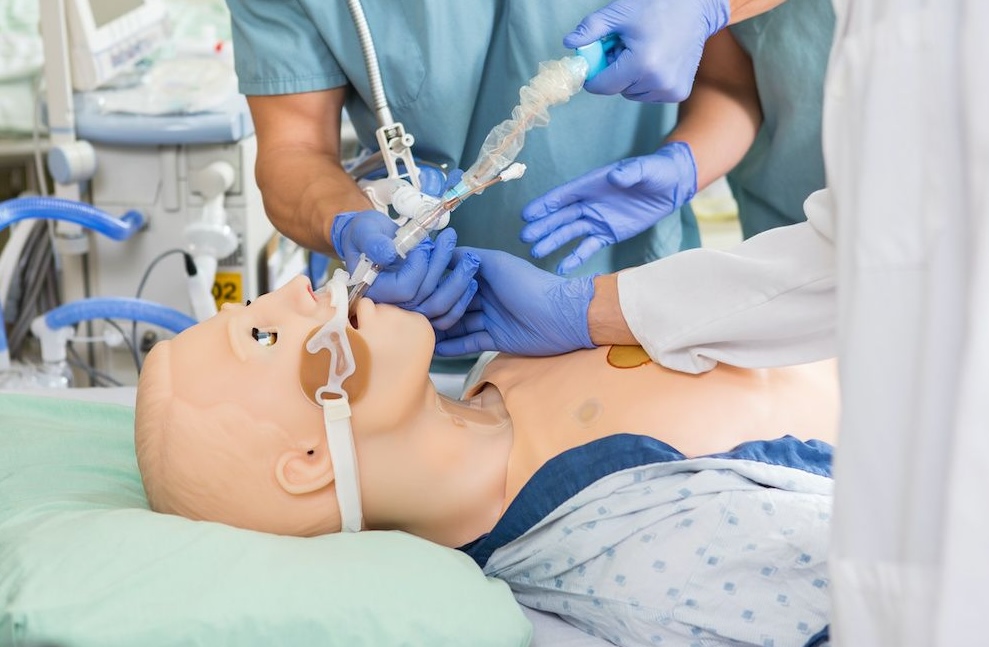Healthcare simulation technical staff are often very knowledgeable about computer technology or film production but may be less knowledgeable about the physiological principles which underlay medical simulation scenarios. This article, which focuses on the basics of hypovolemia, is part 7 of a series of articles entitled Physiology, The Force Behind Simulation – A Guide for Sim Techs (full series linked below) all of which are guest authored by Kim Baily PhD, MSN, RN, CNE, previous Simulation Coordinator for Los Angeles Harbor College and Director of Nursing for El Camino College. Over the past 16 years Kim has developed and implemented several college simulation programs and previously chaired the Southern California Simulation Collaborative. Creating medical simulations that closely mimic clinical practice can assist the learner to stay focused on the scenario learning objectives. This article highlights common IV fluids found in clinical practice and provides an excel templates for IV labels. Intravenous access devices will be discussed in an upcoming article.
In healthy individuals, fluid gain equals fluid loss. Likewise gain and loss of both cations and anions usually balance. For example, when an individual eats a bag of salty chips, the kidneys attempt to excrete the excess sodium. Since the sodium is eliminated in water, water levels in the body decrease. This in turn stimulates the thirst center and the person drinks water. Thus, fluid balance is maintained. This is a simple example but it serves to illustrate fluid balance in the healthy individual. Add numerous electrolytes and physiological pathways and the theory behind fluid and electrolyte balance becomes complicated.
Nevertheless, patients send out signs and symptoms when fluid balance is not within normal limits. For example, blood and urine electrolyte balances change, fluid intake and output change and physiological symptoms of fluid imbalance appear. Vital signs may change, ankles may swell, weight is gained or lost, skin tents or the mouth may be dry. Once a diagnosis of fluid loss or fluid excess is made, fluids may be administered or withheld in an attempt to restore normal physiological levels.
Fluid Replacement:
- Osmolality – measure of the concentration and therefore the osmotic pressure of a solution
- Measured in mOsm/kg of solution.
- Normal 275-295 mOsm/kg (285 +/ – 5 mOsm/Kg)
- ECF osmolality mainly due to Na although glucose and urea contribute a little
- Serum osmolality can be estimated by doubling serum sodium concentration
- (Osmolarity mOsm/L normal 270-300 mOsm/L))
Oral Intake:
- In healthy individuals, fluid intake is through dietary sources.
- The Institute of Medicine has recommended adequate intake (AI) values for total water at levels to prevent dehydration. The AI for men aged 19+ is 3.7 liters each day, and 3 liters (13 cups) of which should be consumed as beverages. The AI for women aged 19+ is 2.7 liters about 2.2 liters (9 cups) of which should be consumed as beverages each day (2016). The amount depends on body size and activity.
- 80% typically comes from beverages and 20% from food
- Patients admitted to hospital may not take in sufficient fluids for a variety of reasons
- Ideally fluid replacement should be with oral solutions. This is the preferred route since this is the safest way to administer fluids.
- If oral fluids (PO) cannot be tolerated, IV fluids will be needed.
- Oral electrolyte solutions may be used which contain 2% glucose and 50-90 mEq/L sodium.
- Most commercial sports drinks contain too much glucose. Glucose can interfere with transport of water into cells.
- Tablets or packets of electrolytes may be ordered.
- Fluids and electrolytes may be administered by nasogastric, gastric or jujunal access devices.
- Determine patient’s favorite beverage
- Limit drinks that have diuretic properties e.g. coffee
- Offer small sips, ice chips, warm versus cold beverages (preferred drink)
- Mouth care, assess for mouth sores
IV Fluids – Classification Based on Tonicity
Tonicity describes effectiveness of all solutes (osmolality) to push or pull water across membranes.
- Isotonic – same osmotic concentration inside and outside cell. No net movement of water. Will not cause cells to change shape. E.g.:
- 0.9% sodium chloride (AKA normal saline)
- Lactated Ringers (contains K, Cl, Na, Calcium)
- Monitor for fluid overload.
- Do not administer Lactated Ringers to patients with severe liver disease – as the liver may be unable to convert lactate to bicarbonate – leads to acidosis or to patients with a pH > 7.5. Monitor potassium levels.
- Hypotonic, exerts less osmotic pressure than the solution with which it is compared. Water will leave extracellular compartment and enter cells, causing them to swell. E.g. 0.45% sodium chloride, 0.25% sodium chloride or 5% dextrose in water (D5W)
- Note: D5W is initially isotonic, but the dextrose is rapidly metabolized and the fluid becomes hypotonic.
- Monitor for inflammation at the IV site.
- Monitor blood sodium levels.
- Do not administer to patients at risk for increased intracranial pressure (head trauma, stroke, neurosurgery). Why is this? Answer at bottom of article!
- Do not administer to patients at risk of third spacing where fluid moves from the vasculature and extracellular spaces into spaces where it becomes trapped and from which it is not easily exchanged. E.g.:
- Peritoneum, pleural and pericardial interstitial spaces causing edema
- Following burns and trauma including surgery (fluid trapped in soft tissue)
- Lack of plasma protein in liver disease
- As much as 5 to 10L may move from one body compartment to another.
- This can lead to a loss of cardiac output and a reduction in blood pressure.
- Hypertonic (>350 mEq/L) – Higher osmotic pressure than cells (i.e. higher solute concentration) – pulls water from cells and causes them to shrink
- e.g. 3% sodium chloride, Dextrose 5% water/sodium chloride 0.9%, Dextrose 5% water/Lactated Ringers, Total Parenteral Nutrition, fluids containing medications.
- Monitor for inflammation at IV site, fluid volume overload and sodium levels.
- Do not administer to patients with diabetic ketoacidosis or impaired cardiac or kidney function.
- High tonicity solutions should be administered through central lines.
Classification of IV fluids based on crystalloids versus colloids
- Crystalloids are smaller molecules that are low cost salt solutions e.g. sodium chloride.
- Colloids are bigger molecules that stay in the blood for longer. The molecules draw fluid into the vascular.
- Colloids may be man-made (e.g. starches, dextrans, or gelatins) or naturally occurring (e.g. albumin or fresh frozen plasma (FFP))
- Colloids are more expensive than crystalloids.
Banana Bag
- Long-standing treatment for vitamin and electrolyte deficiencies in patients with chronic alcohol use disorder.
- Typically contains 100 mg of thiamine, 1mg of folic acid, 1-2 g of magnesium, and a multivitamin formulation in either normal saline or dextrose in water solution.
- In the sim lab, yellow food dye may be added to make the “banana” color.
Total Parenteral Nutrition:
- Basic soluble food elements given parenterally (IV).
IV fluids – General Guidelines for Administration:
- Labeling Bags:
- Name, DOB, age, DOB, MRN, Allergies
- Order number
- Bottle or bag sequence number when appropriate.
- Name and amount of drug.
- Name and volume of admixture solution.
- Total volume of fluid in bag.
- Flow rate in mL/hour
- Date and time of administration.
- Date and time of preparation.
- Expiration date.
- Initials of person who prepared and who checked the IV admixture.
- Auxiliary labeling – supplemental instructions and precautions (e.g. Epidural).
- Typically, drugs considered stable as long as they are within 10% of their labeled potency.
- Consider adding label “Not for human use, for simulation only).
- IV fluids may be used to prevent losses in patients at risk for fluid loss or correct deficits:
- E.g. Patients with nausea and vomiting, other GI disturbances, altered level of consciousness, NPO for tests. Patients with significant sudden changes in fluid balance such as diabetic ketoacidosis.
- IV fluids should be administered cautiously to prevent rapid electrolyte shifts, rapid fluid overload and hyperchloremia induced acidosis.
- Elderly patients are particularly at risk for fluid volume overload.
- Fluids may be replaced at a speed at which they are lost
- If other medications are to be infused into a maintenance IV, check for solution compatibility.
- Monitor IV fluid and site hourly.
- Check site for irritation.
- IV bags come in various sizes 50 – 1000mL (larger for bladder irrigation).
- Mostly plastic bags
- May have air vent
- Must be sterile
- Check expiration of bag.
- Check for contamination, leaks
- Use sterile technique to connect IV tubing
- Changing Bad and/or equipment
- Change IV bag every 24 hours (or as directed by pharmacy or hospital policy)
- Tubing change – maintenance IVs per policy 72-84 hours.
- Some tubing must be replaced daily or after use (e.g. blood tubing).
- IV site change – per policy (frequently 72-84 hours)
- IV access and Central line dressing change – see Part 8 of series.
Download the IV Bag Simulation Template Here!
Simple scenarios for F/E Balance
- Elderly patient admitted with UTI and dehydration. Learning objectives:
- Assessment of signs and symptoms of dehydration.
- Hang appropriate IV fluid
- Complete IV site assessment
- Identify Signs of overload
- Complete patient education to ensure adequate fluid intake at home.
- Heart Failure Patient. Learning Objectives:
- Correctly identify assessment findings for patient with fluid overload.
- Safely administer diuretic (scenario can be changed to either increase or decrease potassium levels).
- Correctly interpret lab electrolyte imbalances.
- Measure all sources of fluid output
- Complete patient education:
- Limit fluid intake – education and support in acute care and at home.
- All sources of fluids counted, including ice chips and water for meds, IVs etc.
- Explain dietary precautions/needs related to fluid imbalances and potential electrolyte changes
Healthcare simulation fidelity is a key component for successful simulation. When IV fluids and infusion equipment such as tubing and pumps are used in a simulation, the equipment and labels should match those found in practice. This will enhance learning and ultimately improve patient safety.
(Answer: Do not administer hypotonic solutions to patients at risk for increased intracranial pressure (head trauma, stroke, neurosurgery). Why is this? Answer: Water moves by osmosis from areas of lower concentration to higher concentration. Infusing hypotonic solutions causes water to leave the vasculature and enter into brain cells causing swelling (cerebral edema)).
Further Reading: Intravenous Fluid Therapy – Intravenous Fluid Therapy in Adults in Hospital
Subscribe for More Great Simulation Resources!
Read the Entire Physiology: The “Force” Behind Healthcare Simulation HealthySimulation.com Article Series:
- Part 1: Blood Pressure
- Part 2: Heart & Respiratory Rate
- Part 3: Pulse Oximetry
- Part 4: Diabetes
- Part 4B: Hypoglycemia & Excel Template for Simulated EHR
- Part 4C: Insulin
- Part 5: Sepsis
- Part 6A: Hypovolemia (Intro)
- Part 6B: Hypovolemia (Treatment & Simulation Tips)
- Part 7A: IV Fluids & Bags
- Part 7B: IV Pumps & Site Access
- Part 7C: PCA for Pain
- Part 8: ABGs
- Part 9: Sepsis Labs









